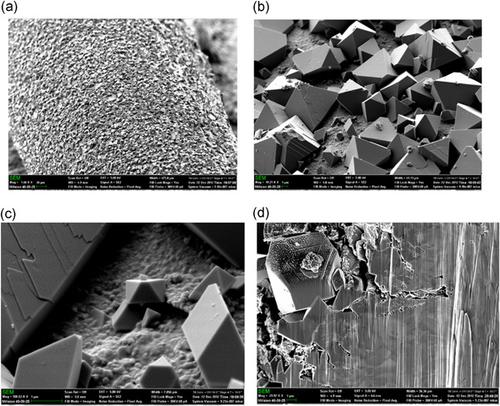当前位置:
X-MOL 学术
›
Mater. Corros.
›
论文详情
Our official English website, www.x-mol.net, welcomes your feedback! (Note: you will need to create a separate account there.)
Further studies on the anaerobic corrosion of carbon steel in alkaline media in support of the Belgian supercontainer concept
Materials and Corrosion ( IF 1.8 ) Pub Date : 2020-11-02 , DOI: 10.1002/maco.202011827 Nicholas R. Smart 1 , Andrew P. Rance 1 , Paul A. H. Fennell 1 , Roberto Gaggiano 2 , Cristiano Padovani 1
Materials and Corrosion ( IF 1.8 ) Pub Date : 2020-11-02 , DOI: 10.1002/maco.202011827 Nicholas R. Smart 1 , Andrew P. Rance 1 , Paul A. H. Fennell 1 , Roberto Gaggiano 2 , Cristiano Padovani 1
Affiliation

|
In the Belgian supercontainer concept, a carbon steel overpack surrounds high‐level radioactive waste and spent fuel containers and is encased in a cementitious buffer material. Research has been carried out to characterise the anaerobic corrosion of carbon steel in an anoxic artificial alkaline porewater that simulates the cementitious buffer material and also in solid cement matrices, in the presence of chloride and the sulphur species expected in the groundwater. The current study focuses on recent results. Specifically, it provides an update on the long‐term corrosion rates obtained from gas generation measurements (including new data from higher‐sensitivity autoclaves) and weight loss measurements and provides results of postmortem analysis of dismantled cells. The behaviour of the system is discussed, focusing on the effects of the solution chemistry, precorrosion treatments and γ radiation on corrosion rates, the electrochemical response of the steel when irradiated, and the morphology of the corrosion product. The corrosion rate was lower in cement than in an aqueous system. Radiation affected the corrosion potential and the morphology of the corrosion product.
中文翻译:

支持比利时超容器概念的碳钢在碱性介质中的厌氧腐蚀的进一步研究
在比利时的超级容器概念中,碳钢外包装包围着高放射性废物和乏燃料容器,并用水泥缓冲材料包裹。已经进行了研究,以表征在缺氧的人工碱性孔隙水中,模拟水泥质缓冲材料以及固体水泥基体中,在存在氯化物和地下水中预期存在的硫的情况下,碳钢的厌氧腐蚀特征。当前的研究集中在最近的结果。具体而言,它提供了从气体生成测量(包括来自更高灵敏度的高压灭菌器的新数据)和失重测量获得的长期腐蚀速率的更新,并提供了拆卸后细胞的事后分析结果。讨论了系统的行为,着重于溶液化学,预腐蚀处理和γ辐射对腐蚀速率的影响,钢在辐照时的电化学响应以及腐蚀产物的形态。水泥中的腐蚀速率低于水性系统。辐射影响腐蚀电位和腐蚀产物的形态。
更新日期:2021-01-05
中文翻译:

支持比利时超容器概念的碳钢在碱性介质中的厌氧腐蚀的进一步研究
在比利时的超级容器概念中,碳钢外包装包围着高放射性废物和乏燃料容器,并用水泥缓冲材料包裹。已经进行了研究,以表征在缺氧的人工碱性孔隙水中,模拟水泥质缓冲材料以及固体水泥基体中,在存在氯化物和地下水中预期存在的硫的情况下,碳钢的厌氧腐蚀特征。当前的研究集中在最近的结果。具体而言,它提供了从气体生成测量(包括来自更高灵敏度的高压灭菌器的新数据)和失重测量获得的长期腐蚀速率的更新,并提供了拆卸后细胞的事后分析结果。讨论了系统的行为,着重于溶液化学,预腐蚀处理和γ辐射对腐蚀速率的影响,钢在辐照时的电化学响应以及腐蚀产物的形态。水泥中的腐蚀速率低于水性系统。辐射影响腐蚀电位和腐蚀产物的形态。



























 京公网安备 11010802027423号
京公网安备 11010802027423号